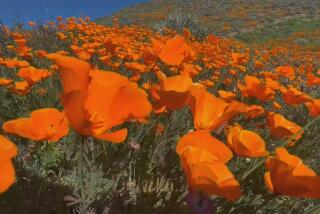Consistency Secret to Thriving Iceland Poppies
- Share via
Last year I learned a few things about Iceland poppies and times to plant. Iceland poppies are those brilliantly colored annuals with the crinkled petals that seem to be made of tissue or crepe. Most are shades of orange or yellow and their thin petals glow like stained glass when back lit by the sun.
They are not considered difficult to grow and are quite common at nurseries, but some people, including me, find them difficult to grow well .
Some people’s poppies stand stiffly upright and the plants are covered with flowers. Others have poppies that are pretty but they lean this way and that and have only a scattering of flowers.
Iceland poppies, and most other spring annuals--calendulas, English daisies, larkspur, pansies, phlox, primroses and the fragrant stock--are usually planted in the fall. But last year, because there was no rain in the fall, I waited until February, hoping it would rain in winter and spring, so I wouldn’t have to water them much. I had to water a little in February, but it rained buckets in March, so my plan worked.
I don’t know if planting late had anything to do with my success, but these February-planted poppies were the best I have ever grown. The problem that plagued Iceland poppies in the recent past was not present in this strain--buds that did not open properly, or at all--duds. These all opened perfectly and they flowered for three months nonstop.
Other things probably had more to do with my success than the time of planting, but I found that there is nothing wrong with planting late for spring bloom. In fact, most of the flowers came after the rains so they were not knocked down by one storm after another as sometimes happens when you plant in the fall and the flowers begin blooming in January or February.
For those who put off planting spring color this year, take heart. You can still do it now. We do not know yet if there will be sufficient rain to end the drought, so it might be wise to plant smaller patches of spring color. My two beds last year held only a couple of dozen plants, but they were centrally located and couldn’t be missed so I got a lot of bang for my buck.
Several years ago, Wayne Roberts, director of the tiny but flower-packed Sherman Gardens in Corona del Mar, told me their secret for growing Iceland poppies and following his tips probably made the difference in my small planting. Most of this information also applies to other spring flowers.
“We fertilize and water consistently. It doesn’t matter what you feed them as long as you are consistent,” Roberts said.
So that’s what I did. I fertilized every other week with one of those soluble fertilizers that come as sticky granules you mix with water. I totally disregarded the old adage to fertilize with something low in nitrogen. I gave them lots of nitrogen, even when they were in flower. The formula I used had 20% nitrogen (it says 20-20-20 on the label; the first 20 stands for the percent of nitrogen). All that nitrogen made for big, healthy plants and those plants sent up hundreds of flower heads.
I also made sure they never lacked water, and they needed more than the other plants in the garden. Because I had planted only a little bed, this was not a drain on the water budget.
I watered them from below so the flowers would not get wet. This is an important point. The weight of water bends the delicate stems and the droplets damage the petals.
Rain tends to flatten Iceland poppies, but if you are quick to cut off the bent and broken flowers, they bounce right back. In between the heavy March rains last year, I had a respectable showing of flowers, just a day after each storm. In fact, that’s when I remembered to take a photograph, though the poppies actually looked their best in April and early May. Individual flowers last only a couple of days.
I followed one other piece of advice from Wayne: deadhead. I did this every other day. I made it an after-work routine. Every other evening I snipped off the stems just below the tops of the leaves with a little pair of scissors. If the plants are allowed to keep their developing seed heads, they stop flowering. I suspect that my diligent deadheading made a big difference.
I should also add that they were growing in the best of soils, laboriously prepared in advance by adding several bags of organic soil amendment. I did not get this last piece of advice from Sherman Gardens because it probably never occurred to them--they already had created the best of soils.
I had no pest problems. Possums ate all the snails in our garden a few years back--gardeners with snails had better bait new plantings--and the squirrel did not discover them. I have heard from others that squirrels eat the buds as if they were crunchy nuts.
I finally pulled the poppies out in late May, to make room for some summer flowers.
Because the seed is incredibly tiny, it’s best to buy young plants in small packs at nurseries. I don’t recommend the larger plants sold in four-inch or “quart” pots. The larger plants have not done as well in my garden--they won’t grow as big or produce as many flowers, though they are a good choice to grow in containers or for real quick, if short-lived, color. Buy a bag or two of soil amendment while you’re at it.
Space the plants about a foot apart and then: 1. Water often and from below, with drip or a soaker. 2. Fertilize every other week. 3. Diligently deadhead. It’s that simple--1-2-3.





